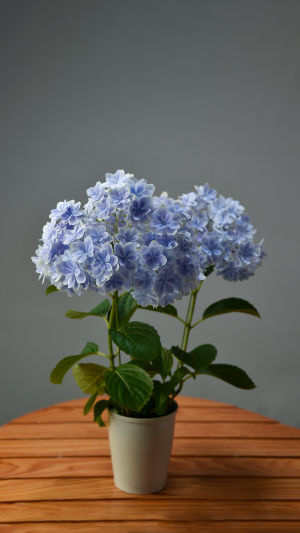Hydrangea is a plant of the genus Hydrangea in the saxifrage family. Its stems often have many branches at the base and its branches are cylindrical.
Flowers are pink, light blue, or white. The flowering period is June to August.
Hydrangea has plump, large, and beautiful flowers. Its color can be red or blue, which is pleasing to the eye. It is a common potted ornamental flower.
The parks built in the early 20th century are also inseparable from the planting of hydrangeas. Modern parks and scenic areas are planted in patches to form a landscape.
Hydrangea is native to Japan and Sichuan, China. And introduced to England in 1736. The cultivation in Holland, Germany, and France is relatively common, and you can see red, blue, purple, and other color hydrangea varieties in flower shops.
There are also many hydrangeas planted in small gardens and in front of buildings.
Besides that, there are other different types of hydrangeas. There are about 70-75 different varieties of hydrangeas, however, there are a few varieties that are most popular among florists, and gardeners.
Hydrangeas are typically divided into three basic flowering types: flat-topped clusters, drag-heads, and panicles.
1. Big-leaf hydrangea
Also known as French hydrangea, this type of hydrangea originated in Japan and is one of the most common types of hydrangea.
2. Rattan Hydrangea
Also known as Japanese hydrangea or creeping hydrangea, this type of hydrangea looks beautiful on houses and arches. It can grow in all kinds of sunlight and tolerate a variety of climates.
3. Wild hydrangea
Wild hydrangea is one of the most famous hydrangea species for its large, showy flowers. While it is not an officially color-changing breed, they typically start out as light green and transition to creamy white.
In addition, different colors of hydrangeas have different symbolic meanings.
1. Pink hydrangea - true and heartfelt emotion.
2. Blue hydrangea—indifference or as an apology.
3. White hydrangea - boast.
4. Purple hydrangea - desire to know a person deeply.
Hydrangeas also have rich meanings throughout the world.
1. Japan: Express love and concern for her, heartfelt affection, understanding, and apology.
2. Victorian era: The flower language of hydrangea represents conceit, especially vanity. They are also sometimes used to reject love or to indicate that someone is cold.
3. North America—Hydrangea has become the flower used for the fourth wedding anniversary. They also symbolize appreciation and sincere affection.
4. The flower language of hydrangea is "reunion and happiness", because its appearance is always round, especially like a happy family.





